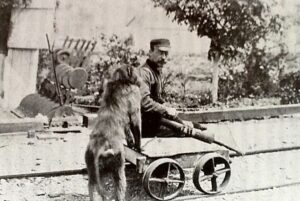 James Edwin Wide had lost both his legs in a work accident years earlier, and so in 1880, when he came across a Chacma Baboon driving an oxcart while visiting a busy South African market, he saw a way to make his life easier. Wide was impressed with the skills, and so he decided to buy him. Having two peg-legs and working had been very difficult on Wide over the years, and finally he saw an end to years of hardship. Impressed by the primate’s skills, Wide bought him, named him Jack, and made him his pet and personal assistant. His original plan was to have Jack drive him on his half-mile commute to the train station. So the first thing he trained the Jack to do was push him to and from work in a small trolley. Soon, Jack was also helping with household chores, sweeping floors and taking out the trash. Jack was very good at his work, and he truly loved Wide, almost as if Wide was his child.
James Edwin Wide had lost both his legs in a work accident years earlier, and so in 1880, when he came across a Chacma Baboon driving an oxcart while visiting a busy South African market, he saw a way to make his life easier. Wide was impressed with the skills, and so he decided to buy him. Having two peg-legs and working had been very difficult on Wide over the years, and finally he saw an end to years of hardship. Impressed by the primate’s skills, Wide bought him, named him Jack, and made him his pet and personal assistant. His original plan was to have Jack drive him on his half-mile commute to the train station. So the first thing he trained the Jack to do was push him to and from work in a small trolley. Soon, Jack was also helping with household chores, sweeping floors and taking out the trash. Jack was very good at his work, and he truly loved Wide, almost as if Wide was his child.
While Jack was very good at his caregiving job, it was at the signal box Jack truly shined. The signal box was a system of manual switches operated in connection with the approaching trains whistles. As trains approached the 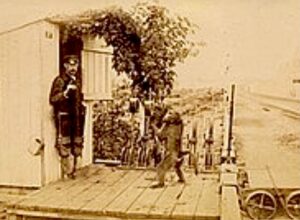 rail switches at the Uitenhage train station, they would toot their whistle a specific number of times to alert the signalman which tracks to change. By watching his owner, Jack picked up the pattern and started tugging on the levers himself. Jack was so smart. He was able to totally take over the signalman’s job that had been held by Wide. Soon, Wide was able to kick back and relax as his furry helper did all of the work switching the rails. According to The Railway Signal, Wide “trained the baboon to such perfection that he was able to sit in his cabin stuffing birds, etc, while the animal, which was chained up outside, pulled all the levers and points.”
rail switches at the Uitenhage train station, they would toot their whistle a specific number of times to alert the signalman which tracks to change. By watching his owner, Jack picked up the pattern and started tugging on the levers himself. Jack was so smart. He was able to totally take over the signalman’s job that had been held by Wide. Soon, Wide was able to kick back and relax as his furry helper did all of the work switching the rails. According to The Railway Signal, Wide “trained the baboon to such perfection that he was able to sit in his cabin stuffing birds, etc, while the animal, which was chained up outside, pulled all the levers and points.”
One day, as the story goes, an upper-class train passenger, looked out the window of the train and saw that a baboon, and not a human, was manning the gears. Of course, this brought outrage, and a complaint to the railway authorities. The authorities decided not to act in haste and fire Wide, decided to resolve the complaint by testing the baboon’s abilities. The result of that test was a group of astounded officials. “Jack knows the signal whistle as well as I do, also every one of the levers,” wrote railway superintendent George B Howe, who visited the baboon sometime around 1890. “It was very touching to see 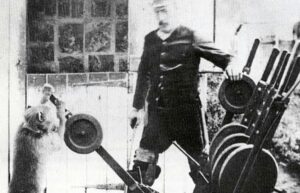 his fondness for his master. As I drew near they were both sitting on the trolley. The baboon’s arms round his master’s neck, the other stroking Wide’s face.”
his fondness for his master. As I drew near they were both sitting on the trolley. The baboon’s arms round his master’s neck, the other stroking Wide’s face.”
The complaint was disregarded and Jack was reportedly given an official employment number, and was paid 20 cents a day and half a bottle of beer weekly. Jack passed away in 1890, after developing tuberculosis. It was a sad day for all who knew him. Jack had worked the rails for nine years, without ever making a mistake. That shows that animals can be trained to do things in a responsible way, and do their job perfectly.
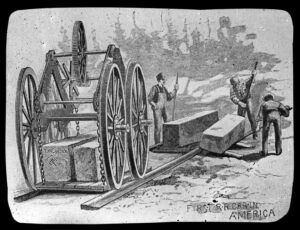 As with any new form of transportation, the first accident is inevitable. There may have been train wrecks in other countries, but the first recorded railroad accident in United States history happened on July 25, 1832, when four people were thrown off a vacant car on the Granite Railway near Quincy, Massachusetts. The people were there by invitation, to watch the process of transporting large and weighty loads of stone. The victims were observing From a vacant car as the large were being loaded. Suddenly, a cable on the vacant car snapped, throwing them off the train and over a 34-foot cliff, one man was killed and the others were seriously injured. It was a fluke, and no one could possibly have known of expected such a break. I suppose that cables had not been used for the purposes they now were…loading large rocks and their duties on trains. Cables can fray and snap. That is just a fact of life. Death is a fact of life, and on that day, when the cable broke, the wagon containing Thomas B Achuas of Cuba was killed when the wagon derailed as he and three other tourists were taking a tour.
As with any new form of transportation, the first accident is inevitable. There may have been train wrecks in other countries, but the first recorded railroad accident in United States history happened on July 25, 1832, when four people were thrown off a vacant car on the Granite Railway near Quincy, Massachusetts. The people were there by invitation, to watch the process of transporting large and weighty loads of stone. The victims were observing From a vacant car as the large were being loaded. Suddenly, a cable on the vacant car snapped, throwing them off the train and over a 34-foot cliff, one man was killed and the others were seriously injured. It was a fluke, and no one could possibly have known of expected such a break. I suppose that cables had not been used for the purposes they now were…loading large rocks and their duties on trains. Cables can fray and snap. That is just a fact of life. Death is a fact of life, and on that day, when the cable broke, the wagon containing Thomas B Achuas of Cuba was killed when the wagon derailed as he and three other tourists were taking a tour.
While it was a setback, trains were, in fact, a matter of necessity, and the acceptance of railroads came quickly in the 1830s and beyond. By 1840 the United States had almost 3,000 miles of railway, which was more than the combined European total of only 1,800 miles. The railroad network expanded quickly in the years before the Civil War, and by 1860 the American railroad system had become a national network of some 30,000 miles. 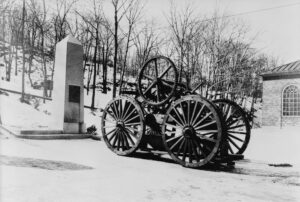 Nine years later, transcontinental railroad service became possible for the first time. These were great successes, but they did not come without a price, and sometimes that price is very heavy.
Nine years later, transcontinental railroad service became possible for the first time. These were great successes, but they did not come without a price, and sometimes that price is very heavy.
When architect Solomon Willard arrived in Quincy, Massachusetts, in 1825, and discovered a granite ledge in a wooded area, he knew he had found the perfect raw material for what would become his most famous building, the Bunker Hill Monument. Willard envisioned a 221-foot tall monument with a 30 feet square base that would require some 6,700 tons of granite. Transporting the massive blocks of granite from the quarry to the site of construction presented a challenge. That’s where the train came in. Quincy was separated from Charlestown, where the monument would be erected, by 12 miles of swamp, forest, and farms. The granite needed to be delivered to Neponset River, four miles north, from where a barge would transport the stone through Boston Harbor to Charlestown. Willard wanted to move the stones to the Neponset River on sledges during winter, but engineer Gridley Bryant, suggested a more efficient method…a railroad.
With the support Boston businessman and state legislator Thomas Handasyd Perkins, Bryant ended up designing what would become the first, commercial railroad in the United states. Rather than steam locomotives, Bryant used horses to pull the railcars a distance of three miles from quarries to the Neponset  River. A single horse could pull three cars loaded with 16 tons of rock over wooden rails plated with iron. Later, the wooden rails were replaced with granite rails. The iron plates were retained.
River. A single horse could pull three cars loaded with 16 tons of rock over wooden rails plated with iron. Later, the wooden rails were replaced with granite rails. The iron plates were retained.
Although, Bryant benefitted from developments already in use on railroads in England, he did modify his design to allow for heavier, more concentrated loads and a three-foot frost line. The Granite Railway also introduced several important inventions, including railway switches or frogs, the turntable, and double-truck railroad cars. Gridley Bryant never patented his inventions, believing they should be for the benefit of all.
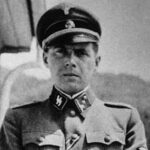
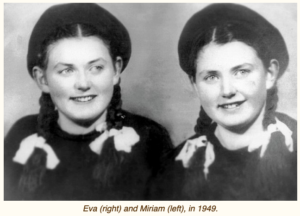 Approximately 3,000 twins were pulled from the masses on the ramp at Auschwitz, most of them were children; only around 160 of them survived. As the trains rolled into Auschwitz, the guards were trained to watch closely. They were looking for strong workers, the elderly, and the weak, and they were looking for twins…especially identical twins. The parents of these twins were thankful that they had twins…at first. They seemed to know that their twins would not be sent to the gas chambers, but they did not know that they would be taken away from them forever, and that they would be sentenced to a life of torture in the hands of a madman. The Nazis didn’t care about the feelings of the parents whose twins were yanked from their arms. They knew that Dr Josef Mengele wanted these twins for his medical experiments. Mengele wanted to find a way to cause more twin births to increase the Nazi world population. He also wanted to find a way to manipulate the traits twins had so that if they were blonde haired, a trait that supposedly meant that they were half Aryan. That said, he wanted to bring any problematic areas into line, such as the lack of blue eyes. He would inject chemicals into their eyes to try to turn their eyes blue. And that was just part of his insanely sadistic experimentation.
Approximately 3,000 twins were pulled from the masses on the ramp at Auschwitz, most of them were children; only around 160 of them survived. As the trains rolled into Auschwitz, the guards were trained to watch closely. They were looking for strong workers, the elderly, and the weak, and they were looking for twins…especially identical twins. The parents of these twins were thankful that they had twins…at first. They seemed to know that their twins would not be sent to the gas chambers, but they did not know that they would be taken away from them forever, and that they would be sentenced to a life of torture in the hands of a madman. The Nazis didn’t care about the feelings of the parents whose twins were yanked from their arms. They knew that Dr Josef Mengele wanted these twins for his medical experiments. Mengele wanted to find a way to cause more twin births to increase the Nazi world population. He also wanted to find a way to manipulate the traits twins had so that if they were blonde haired, a trait that supposedly meant that they were half Aryan. That said, he wanted to bring any problematic areas into line, such as the lack of blue eyes. He would inject chemicals into their eyes to try to turn their eyes blue. And that was just part of his insanely sadistic experimentation.
Ten-year-old Eva (Mozes) Kor and her twin sister, Miriam (Mozes) Zeiger, were one of these surviving sets of twins. The twins were born on January 31, 1934 into a Jewish farming family in the village of Portz in northern Transylvania, which was a part of Romania at the time, but later became a part of Hungary, which came under German military occupation in late World War II. Their family was deported to Auschwitz in late 1944, a fact which probably was to their advantage, because they were at Auschwitz for a shorted time that some survivors. The twins father, Alexander; their mother, Jaffa; and sisters, Edit and Aliz; all died at Auschwitz.
Eva and Miriam spent nine months in the clutches of Dr Mengele, during which time he would inject them with mystery cocktails of germs, viruses, and chemicals…just to see how they would react. Following one such injection, Miriam’s kidneys stopped growing. They remained the size of a child’s for the rest of her life. Eva recalls that after one injection, she became very ill, with a high fever. During her illness, she kept telling herself that she must survive, or else Miriam would become “surplus to requirements,” meaning that she would be given a lethal injection of something so that dual autopsies could be performed on them. Mengele wanted to see any differences the twins might have. The girls were determined that they would survive for each other.
Dr Mengele who has killed about 1,500 pairs of twins in two years, was known to perform horrible surgeries on twins, without anesthesia. One day the girls saw a set of twins brought into the barracks after surgery. The twins had been connected at their backs. Their organs had been interconnected. They were in horrible pain, and they died a short time later. While the “Mengele Twins” were given “special privileges” in some ways, better clothes and food, they were not spared the horrors of death. They saw it all around them, and they had no one to comfort them after they witnessed these horrors.
Then it happened…on January 27, 1945, while Eva and Miriam are lying in their bunks, the girls heard shouts of 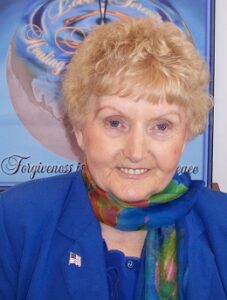
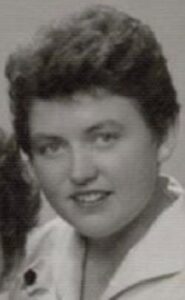 “We’re free! We’re free!” They ran to the door of the barracks, but couldn’t see anything for a few minutes because of the snow. Then they saw the Soviet soldiers in white camouflage. It was a wonderful day for them. The girls immigrated to Israel and lived in a Kibbutz that had been set up for children orphaned by the Holocaust. The grew up and both married, but only Eva had children. Miriam passed away on June 6, 1993. Eva went on to forgive the Nazis for the atrocities against the Jews. She not only forgave them, but she took young people on annual tours of the Auschwitz complex, because she didn’t want people to forget what happened there. She actually passed away while on one of those tours on July 4, 2019. These were amazing women. Would that we could all forgive in such a manner.
“We’re free! We’re free!” They ran to the door of the barracks, but couldn’t see anything for a few minutes because of the snow. Then they saw the Soviet soldiers in white camouflage. It was a wonderful day for them. The girls immigrated to Israel and lived in a Kibbutz that had been set up for children orphaned by the Holocaust. The grew up and both married, but only Eva had children. Miriam passed away on June 6, 1993. Eva went on to forgive the Nazis for the atrocities against the Jews. She not only forgave them, but she took young people on annual tours of the Auschwitz complex, because she didn’t want people to forget what happened there. She actually passed away while on one of those tours on July 4, 2019. These were amazing women. Would that we could all forgive in such a manner.
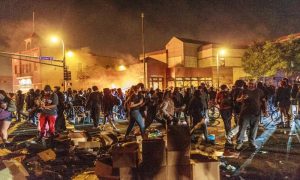
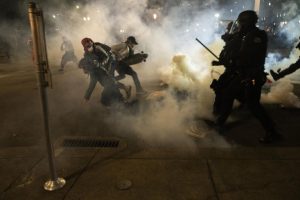 The other day, while in the Black Hills, I was spending time in one of my favorite pastimes…people watching. Keystone, South Dakota is an interesting mix of people, and somehow everyone gets along and mingles with ease. There is no animosity in Keystone. Everyone is in a relaxed, party mood and even when they are waiting in line to order food, and the line is really long, and things are taking some time, nobody gets upset. They are kind to each other and they are patient. I watched people from all walks of life. There were bikers standing next to what appeared to me to be a doctor and his family, and there were smiles all around. People helped those who needed help, opened doors for each other; and by the way, color made no difference. In the year following a year of riots, unrest, racism, and rudeness, this was Heaven.
The other day, while in the Black Hills, I was spending time in one of my favorite pastimes…people watching. Keystone, South Dakota is an interesting mix of people, and somehow everyone gets along and mingles with ease. There is no animosity in Keystone. Everyone is in a relaxed, party mood and even when they are waiting in line to order food, and the line is really long, and things are taking some time, nobody gets upset. They are kind to each other and they are patient. I watched people from all walks of life. There were bikers standing next to what appeared to me to be a doctor and his family, and there were smiles all around. People helped those who needed help, opened doors for each other; and by the way, color made no difference. In the year following a year of riots, unrest, racism, and rudeness, this was Heaven.
Of course, we were in South Dakota…a Republican state that did not close down for Covid. I’m not going to get too deeply into politics here, but it is impossible not to notice the difference in the states. I was in Keystone when President Trump was at Rushmore, and there were protests, but no real violence, no riots, and no vandalism. People were just different there…more polite, more civil, more caring. Even in the midst of a protest, when people were calling out their own views, there was no violence. That means something. It means that people can disagree without being hateful. It also means that certain things were not going to be tolerated, and those who would act out should know they would be arrested. Of course, the police were everywhere, and having a police presence is crucial to keeping order. I am aware that there are good cops and bad cops, but in Keystone, it seemed that the police officers were good and caring, because they wanted the honor that went with being good cops.
There are also good people and bad people, and there are those who are paid to be evil. And those are the worst kind of all. People talk about the naivete of the rural people of our country, but I think they are some of 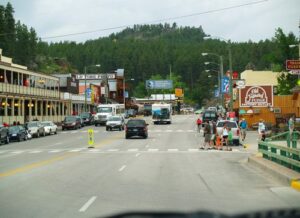
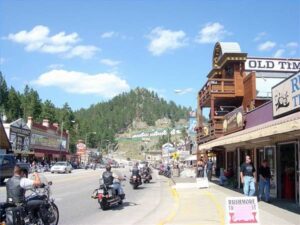 the best people there are. Those good old fashioned values, caring about your neighbors, helping others, and not looking at the color of someone’s skin, those are the kind of people I see in rural America. I wouldn’t want to live in a big city, because I think you lose a lot of that loving, caring lifestyle. That is what we need to work toward getting back in this country…a more caring lifestyle.
the best people there are. Those good old fashioned values, caring about your neighbors, helping others, and not looking at the color of someone’s skin, those are the kind of people I see in rural America. I wouldn’t want to live in a big city, because I think you lose a lot of that loving, caring lifestyle. That is what we need to work toward getting back in this country…a more caring lifestyle.
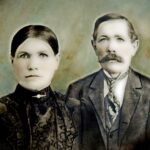
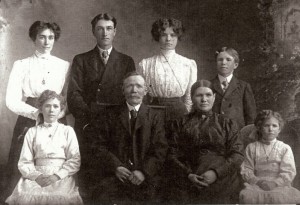 My great grandparents, Carl and Henriette (Hensel) Schumacher were farmers, first in Minnesota and then in North Dakota, where they owned land in the famous Red River Valley. I had heard of the Red River Valley as a child, but only from the old song that bears it’s name. Recently, while preparing for a trip with three of my sisters; Cheryl Masterson, Caryl Reed, and Alena Stevens; to Wisconsin and deciding to go through Fargo, North Dakota to visit our great grandparents’ graves, I was reading through my great aunt Bertha (Schumacher) Hallgren’s journal to get more information, when I came across the fact that my great grandparents had actually lived in the Red River Valley when they moved to Fargo, North Dakota. For a farmer, to live in such a fertile area and not be able to farm the land must have been just awful.
My great grandparents, Carl and Henriette (Hensel) Schumacher were farmers, first in Minnesota and then in North Dakota, where they owned land in the famous Red River Valley. I had heard of the Red River Valley as a child, but only from the old song that bears it’s name. Recently, while preparing for a trip with three of my sisters; Cheryl Masterson, Caryl Reed, and Alena Stevens; to Wisconsin and deciding to go through Fargo, North Dakota to visit our great grandparents’ graves, I was reading through my great aunt Bertha (Schumacher) Hallgren’s journal to get more information, when I came across the fact that my great grandparents had actually lived in the Red River Valley when they moved to Fargo, North Dakota. For a farmer, to live in such a fertile area and not be able to farm the land must have been just awful.
They had farmed in the Lisbon, North Dakota area. Later they moved to Fargo, when Great Grandma became ill, and the family left the farm for good. For my great aunts, Mina (Schumacher) Spare and Elsa (Schumacher) Lawrence, the move to Fargo was a welcomed one. They never really loved the farming lifestyle, and they saw the move to Fargo as a definite “step up” in the world. For Bertha and Great Grandpa, it was one of the saddest moments in their lives. They loved the outdoors, farming, and especially the Red River Valley’s fertile ground. They would take walks in the spring, summer, and fall, walking two to three miles to the edge of town to look out on the fields of crops that grew in the Red River Valley. They always wished they could go back to farming, but Grandma needed to be in town and closer to medical care. It wasn’t just this illness that plagued her, but the fact that the last nineteen years of her life were spent in a wheelchair, that made the need for closeness to doctors and hospitals so important.
My guess is that both Great Grandpa and Great Aunt Bertha hoped that someday they might be able to move to the farmland of the Red River Valley, but I expect that they knew deep down inside that it was not to be. Great Grandpa was getting on in years, and grandma was never going to get well enough to move back to the country. The wheelchair was extremely limiting. Sadly, there was a medicine that came from Germany that was helping 
 Great Grandma, but it became unavailable during World War I, so the doctor did other drastic treatments…electric shock treatments and drawing up the cords in her knees, which rendered her wheelchair bound for the rest of her life. For Great Grandpa and Great Aunt Bertha, they were thankful that they could walk out to the edge of town and see the Red River Valley, but always sad that they could not walk those crop fields and dig in the fertile dirt there. They would always miss farming.
Great Grandma, but it became unavailable during World War I, so the doctor did other drastic treatments…electric shock treatments and drawing up the cords in her knees, which rendered her wheelchair bound for the rest of her life. For Great Grandpa and Great Aunt Bertha, they were thankful that they could walk out to the edge of town and see the Red River Valley, but always sad that they could not walk those crop fields and dig in the fertile dirt there. They would always miss farming.
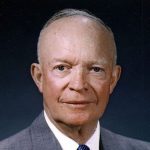 Some nations really can’t be trusted with weapons of mass destruction. They are eager to start a war, and they don’t have the moral scruples necessary to care about the loss of life involved. When nuclear weapons began to be produced, nations like the Soviet Union, China, Germany, Iran, Iraq, and various others, simply couldn’t be trusted with these weapons, but it was difficult to stop them from developing them, just like it is today. Therefore, nations have had to develop ways to restrict the usage of these weapons.
Some nations really can’t be trusted with weapons of mass destruction. They are eager to start a war, and they don’t have the moral scruples necessary to care about the loss of life involved. When nuclear weapons began to be produced, nations like the Soviet Union, China, Germany, Iran, Iraq, and various others, simply couldn’t be trusted with these weapons, but it was difficult to stop them from developing them, just like it is today. Therefore, nations have had to develop ways to restrict the usage of these weapons.
On July 21, 1955, President Dwight D Eisenhower presented his “Open Skies” plan at the 1955 Geneva summit meeting with Prime Minister Anthony Eden of Great Britain, Premier Edgar Faure of France, and Premier Nikolai Bulganin of the Soviet Union…acting for Soviet leader Nikita Khrushchev, in Geneva in July 1955, to present the plan. The plan was never accepted, but it laid the foundation for President Ronald Reagan’s “Trust, But Verify” policy in relation to arms agreements with the Soviet Union. The planned agenda for the summit included discussions on the future of Germany and arms control, but as it became clear that no agreement could be 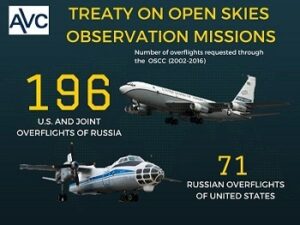 reached on the issue of possible German reunification or the precise configuration of an arms control agreement, considering what had happened in Germany after World War I, Eisenhower dramatically unveiled what came to be known as his “Open Skies” proposal. The proposal called for the United States and the Soviet Union to exchange maps indicating the exact location of every military installation in their respective nations. The purpose of the maps was to allow each nation to conduct aerial surveillance of the installations in order to assure that the other nations were in compliance with any arms control agreements that might be reached. While it sounded like a good idea, it had little chance of acceptance. The French and British expressed interest in the idea, but the Soviets rejected any plan that would leave their nation subject to surveillance by a Western power. Khrushchev declared that Eisenhower’s “Open Skies” was nothing more than an “espionage plot.”
reached on the issue of possible German reunification or the precise configuration of an arms control agreement, considering what had happened in Germany after World War I, Eisenhower dramatically unveiled what came to be known as his “Open Skies” proposal. The proposal called for the United States and the Soviet Union to exchange maps indicating the exact location of every military installation in their respective nations. The purpose of the maps was to allow each nation to conduct aerial surveillance of the installations in order to assure that the other nations were in compliance with any arms control agreements that might be reached. While it sounded like a good idea, it had little chance of acceptance. The French and British expressed interest in the idea, but the Soviets rejected any plan that would leave their nation subject to surveillance by a Western power. Khrushchev declared that Eisenhower’s “Open Skies” was nothing more than an “espionage plot.”
The truth is that “Open Skies” was definitely not an “espionage plot,” but then we all knew that. Eisenhower was later quoted as saying that he knew “the Soviets would never accept the plan, but thought that their rejection of the idea would make the Russians look like they were the major impediment to an arms control  agreement.” The problem the Soviets had was that US surveillance planes would quickly find out that the Soviet Union was far behind the United States in terms of its military capabilities. The United States soon found that out anyway, because just a few months after the Soviet rejection of “Open Skies,” the Eisenhower administration approved the use of high-altitude spy planes (the famous U-2s) for spying on the Soviet Union. Thirty years later, President Reagan would use much the same rhetoric in his arms control dealings with the Soviet Union. Arms control, he declared, could only be effective if compliance with such agreements could be verified. “Trust, but verify” became Reagan’s standard phrase, and the truth is they were both right. If these rogue nations can’t be held accountable, they will continue to develop weapons of mass destruction, even while they are in a supposed agreement not to.
agreement.” The problem the Soviets had was that US surveillance planes would quickly find out that the Soviet Union was far behind the United States in terms of its military capabilities. The United States soon found that out anyway, because just a few months after the Soviet rejection of “Open Skies,” the Eisenhower administration approved the use of high-altitude spy planes (the famous U-2s) for spying on the Soviet Union. Thirty years later, President Reagan would use much the same rhetoric in his arms control dealings with the Soviet Union. Arms control, he declared, could only be effective if compliance with such agreements could be verified. “Trust, but verify” became Reagan’s standard phrase, and the truth is they were both right. If these rogue nations can’t be held accountable, they will continue to develop weapons of mass destruction, even while they are in a supposed agreement not to.
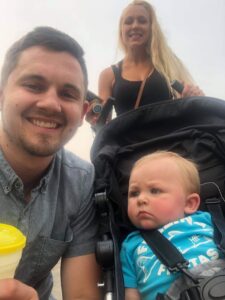
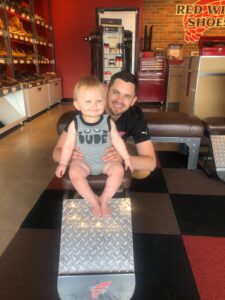 My grand-niece, Katy Balcerzak’s fiancé, Dylan Herr is co-owner, with his dad, Robert Herr, of Red Wing Shoes. They have stores in Casper, Wyoming; Cheyenne, Wyoming; and Brighton, Colorado. Recently Dylan, Katy, and their precious son, Max moved from Brighton to Casper to run the new store here. The only bad thing about that is that, at least for now, Dylan is working 7 days a week, and periodically traveling to Cheyenne and Brighton to check on things there. The Herr family has owned a Red Wing Shoe Stores franchise for three generations. They continue to expand and grow in sales.
My grand-niece, Katy Balcerzak’s fiancé, Dylan Herr is co-owner, with his dad, Robert Herr, of Red Wing Shoes. They have stores in Casper, Wyoming; Cheyenne, Wyoming; and Brighton, Colorado. Recently Dylan, Katy, and their precious son, Max moved from Brighton to Casper to run the new store here. The only bad thing about that is that, at least for now, Dylan is working 7 days a week, and periodically traveling to Cheyenne and Brighton to check on things there. The Herr family has owned a Red Wing Shoe Stores franchise for three generations. They continue to expand and grow in sales.
Dylan and Katy recently bought their first house here in Casper, and he has become quite the handyman. He put together a swing set for Max, which as we all know, is not the easiest of projects. He has also completely transformed the 
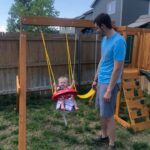 yard at the house, which needed a lot of work to take it from dead weeds to green grass. Being a homeowner is, as most of us know or find out quickly, a rather large and never ending job. Houses, while wonderful to have, are always in need of some kind of work. Dylan seems to have a knack for that kind of thing, so I’m sure those little projects are really rather fun. It’s always exciting to put your own stamp on your new home, and to show your unique style. Dylan and Katy have been doing just that since they moved back to Casper.
yard at the house, which needed a lot of work to take it from dead weeds to green grass. Being a homeowner is, as most of us know or find out quickly, a rather large and never ending job. Houses, while wonderful to have, are always in need of some kind of work. Dylan seems to have a knack for that kind of thing, so I’m sure those little projects are really rather fun. It’s always exciting to put your own stamp on your new home, and to show your unique style. Dylan and Katy have been doing just that since they moved back to Casper.
Dylan is a very patient and kind person. That is truly what made Katy love him so, and why Max thinks he is 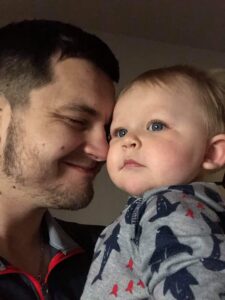
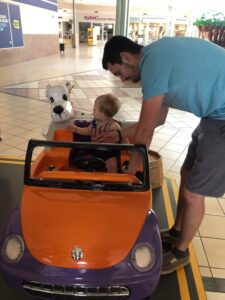 the greatest daddy on Earth. Having moved to Casper, Dylan misses his parents, Robert and Dee Dee Herr, and his brother Tyler Herr and his wife, Amber, and they miss him, Katy, and Max very much. They are all a close family, including the grandparents, and that makes a move hard. It’s always hard to live far from your kids…especially when the grandchildren begin to show up. Dylan’s parent and brother are all very close to Dylan’s little family, and it makes it hard, but thankfully it isn’t too far away. they can get up for weekends and such once in a while, and that helps a lot. Dylan and Katy are starting this new adventure in her home town, and we are very happy for them. Today is Dylan’s birthday. Happy birthday Dylan!! Have a great day!! We love you!!
the greatest daddy on Earth. Having moved to Casper, Dylan misses his parents, Robert and Dee Dee Herr, and his brother Tyler Herr and his wife, Amber, and they miss him, Katy, and Max very much. They are all a close family, including the grandparents, and that makes a move hard. It’s always hard to live far from your kids…especially when the grandchildren begin to show up. Dylan’s parent and brother are all very close to Dylan’s little family, and it makes it hard, but thankfully it isn’t too far away. they can get up for weekends and such once in a while, and that helps a lot. Dylan and Katy are starting this new adventure in her home town, and we are very happy for them. Today is Dylan’s birthday. Happy birthday Dylan!! Have a great day!! We love you!!
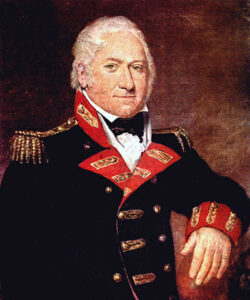 Most of us have heard of shrapnel. Shrapnel shells have been obsolete since the end of World War I for anti-personnel use, but they were “anti-personnel artillery munitions which carried many individual bullets close to a target area and then ejected them to allow them to continue along the shell’s trajectory and strike targets individually. They relied almost entirely on the shell’s velocity for their lethality.” These days, high-explosive shells are used for that role. The functioning and principles behind Shrapnel shells are fundamentally different from high-explosive shell fragmentation. Shrapnel is named for its inventor, Lieutenant-General Henry Shrapnel (1761–1842). Shrapnel was a British artillery officer, whose experiments, initially conducted on his own time and at his own expense, culminated in the design and development of a new type of artillery shell.
Most of us have heard of shrapnel. Shrapnel shells have been obsolete since the end of World War I for anti-personnel use, but they were “anti-personnel artillery munitions which carried many individual bullets close to a target area and then ejected them to allow them to continue along the shell’s trajectory and strike targets individually. They relied almost entirely on the shell’s velocity for their lethality.” These days, high-explosive shells are used for that role. The functioning and principles behind Shrapnel shells are fundamentally different from high-explosive shell fragmentation. Shrapnel is named for its inventor, Lieutenant-General Henry Shrapnel (1761–1842). Shrapnel was a British artillery officer, whose experiments, initially conducted on his own time and at his own expense, culminated in the design and development of a new type of artillery shell.
Henry Shrapnel was born June 3, 1761 at Midway Manor in Bradford-on-Avon, Wiltshire, England, the ninth child of Zachariah Shrapnel and his wife, Lydia. Shrapnel became an artillery officer and inventor of a form of artillery case shot (shrapnel). He was commissioned in the  Royal Artillery in 1779, and served in Newfoundland, Gibraltar, and the West Indies. He was wounded in Flanders in the Duke of York’s unsuccessful campaign against the French in 1793. In 1804 he became an inspector of artillery and spent several years at Woolwich arsenal.
Royal Artillery in 1779, and served in Newfoundland, Gibraltar, and the West Indies. He was wounded in Flanders in the Duke of York’s unsuccessful campaign against the French in 1793. In 1804 he became an inspector of artillery and spent several years at Woolwich arsenal.
In 1784, while a lieutenant in the Royal Artillery, he perfected, with his own resources, an invention of what he called “spherical case” ammunition: a hollow cannonball filled with lead shot that burst in mid-air. He successfully demonstrated this in 1787 at Gibraltar. He intended the device as an anti-personnel weapon. In 1803, the British Army adopted a similar, but elongated explosive shell which immediately acquired the inventor’s name. It has lent the term “shrapnel” to fragmentation from artillery shells and fragmentation in general ever since, long after it was replaced by high explosive rounds, but this usage is not the original 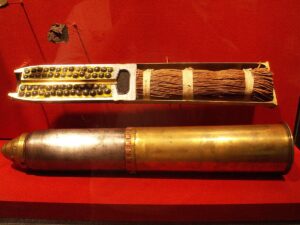 meaning of the word. Until the end of World War I, the shells were still manufactured according to his original principles.
meaning of the word. Until the end of World War I, the shells were still manufactured according to his original principles.
In 1814, the British Government recognized Shrapnel’s contribution by awarding him £1200 (UK£ 85,000 in 2021) a year for life, however, bureaucracy kept him from receiving the full benefit of this award. He was promoted to the office of Colonel-Commandant, Royal Artillery, on March 6, 1827, and to the rank of lieutenant-general on January 10, 1837. Shrapnel lived at Peartree House, near Peartree Green, Southampton from about 1835 until his death on March 13, 1842 at Southampton, Hampshire.

 My grand-nephew, James Renville met the love of his life, Manuela Ortiz a couple of years ago, and from that point forward, they knew that it was love. Theirs was not the easiest of courtships, because Manuela worked in New Jersey, and James lives in Casper, Wyoming. That was not a deterrent for James, however, because when it comes to the perfect one…love will find a way. The good news is that James loves to travel, so traveling to see this girl who has captured his heart was no hardship at all. The only hardship was leaving her to come back home.
My grand-nephew, James Renville met the love of his life, Manuela Ortiz a couple of years ago, and from that point forward, they knew that it was love. Theirs was not the easiest of courtships, because Manuela worked in New Jersey, and James lives in Casper, Wyoming. That was not a deterrent for James, however, because when it comes to the perfect one…love will find a way. The good news is that James loves to travel, so traveling to see this girl who has captured his heart was no hardship at all. The only hardship was leaving her to come back home.
James and Manuela longed for the day when they would no longer have to be separated by the miles between 
 their jobs. When love is real, you never want to be so far apart. Your hearts are as one, and you know that it is time to begin to build your own life together. That is exactly how James and Manuela felt. While their relationship began with distance making things difficult, it did not stop love from growing, and now they can put those miles behind them, and go forward as one. Their families are so excited for them to become man and wife.
their jobs. When love is real, you never want to be so far apart. Your hearts are as one, and you know that it is time to begin to build your own life together. That is exactly how James and Manuela felt. While their relationship began with distance making things difficult, it did not stop love from growing, and now they can put those miles behind them, and go forward as one. Their families are so excited for them to become man and wife.
A short time ago, in October, James popped the question, and Manuela said yes. With that one little word, James’ life suddenly felt complete. Manuela was the girl of his dreams, and the one his mother had been praying for to 
 complete her son. In fact, Manuela is so sweet, that our whole family loves her dearly, and we can’t wait to make her a part of our family. Well, today is that day. James and Manuela have chosen Bear Trap Meadow as the site for their wedding, and they really couldn’t have picked a prettier site. The excitement is building, and we can’t wait to watch this beautiful wedding take place. Love is truly in the air, and love has found a way for these two precious people. Congratulations as you go forward in marriage, James and Manuela. We love you both very much, and wish for you two, the greatest blessings that God has to give.
complete her son. In fact, Manuela is so sweet, that our whole family loves her dearly, and we can’t wait to make her a part of our family. Well, today is that day. James and Manuela have chosen Bear Trap Meadow as the site for their wedding, and they really couldn’t have picked a prettier site. The excitement is building, and we can’t wait to watch this beautiful wedding take place. Love is truly in the air, and love has found a way for these two precious people. Congratulations as you go forward in marriage, James and Manuela. We love you both very much, and wish for you two, the greatest blessings that God has to give.
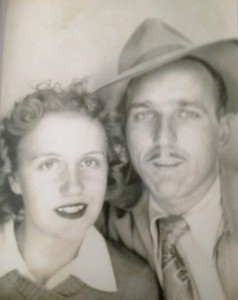
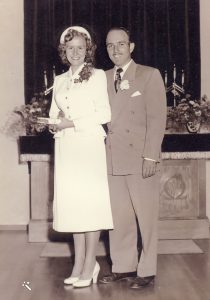 As another of my parents, Al and Collene Spencer’s anniversaries comes around again, I find myself wondering how it could be that they have been in Heaven for so long now. Dad left us in 2007 and Mom left in 2015. They were so in love, for so many years, and now they are back together again, and I know they are so happy. Mom and Dad got married when she was just 17, and they were parents just 10 months later. That was common in that era. Most couple got married, and the babies started coming in rapid succession. For Mom and Dad, that meant a new daughter every two years, with the exception of my sister, Caryl Reed, who followed my breech birth at three years later. I suppose Mom should have had a C-section with me, but it seems the doctors thought it wouldn’t be a problem, if they just dislocated my hips for the birth. A strange thought these days, but I did survive, so I won’t complain.
As another of my parents, Al and Collene Spencer’s anniversaries comes around again, I find myself wondering how it could be that they have been in Heaven for so long now. Dad left us in 2007 and Mom left in 2015. They were so in love, for so many years, and now they are back together again, and I know they are so happy. Mom and Dad got married when she was just 17, and they were parents just 10 months later. That was common in that era. Most couple got married, and the babies started coming in rapid succession. For Mom and Dad, that meant a new daughter every two years, with the exception of my sister, Caryl Reed, who followed my breech birth at three years later. I suppose Mom should have had a C-section with me, but it seems the doctors thought it wouldn’t be a problem, if they just dislocated my hips for the birth. A strange thought these days, but I did survive, so I won’t complain.
Mom and Dad, were not to have a son, and I think that as the years went by, they considered their daughters to be a blessing…or at least we hope they did. When it came time to take care of them in their later years, they were very glad they had daughters, because we became caregivers without even questioning the idea. We all agreed that our parents were worth every sacrifice that might need to be made. They were such good parents to us, and we all feel honored to have be given such wonderful, loving parents to raise us and show us the right way to go in life. We never had to try to find God in our life, because we were raised in church, by our responsible parents, and I think each of us can honestly say that there is no time in our life when we didn’t know God. We didn’t have a day when we found Jesus. He lived in our house from the day they married, and we always knew him.
Mom and Dad had a wonderful, loving relationship, and they were demonstrative about their love. They kissed in front of us…daily. Dad gave Mom a love pat on the derrière when he got home from work, and we all knew it was in love. Dad always called her “Doll” and for years, I thought that was her name. He always sent flowers on their anniversary and her birthday, and chocolates on Christmas, and of course, with her January 1st birthday, there was always a big party for New Years Eve. Mom always treated Christmas and his birthday with the same special kinds of things, although, not the same ones as he gave her…of course. They loved spending time together, and eventually worked together. They relished their time together in retirement too…wanting nothing more than time together. Sometimes people fight when they are together too much, but not my parents. They just enjoyed their life together.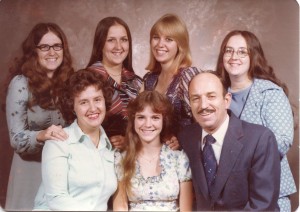
They loved going camping and made sure that my sisters and I always got a summer vacation trip. Dad loved to travel all his life, and so teaching his girls (Mom too) a love of travel was a big thing for Dad. He may have been outnumbered by girls, but I think Dad considered it a blessing, except when he needed in the bathroom, and it was occupied. How he survived that little house with just one bathroom and 6 women trying to get ready, I’ll never know. Nevertheless, with the many trials of having girls, Mom and Dad wouldn’t have changed a thing. It was a wonderful life. Happy 68th Wedding Anniversary in Heaven, Mom and Dad. We love and miss you both very much.

